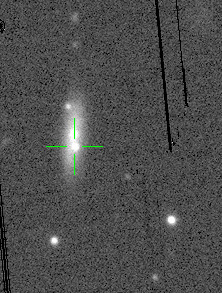 2022bn,
2022ec, and
2022pv
3 supernovae at the same time! in
NGC 5605
(References:
SYFY article)
2022bn,
2022ec, and
2022pv
3 supernovae at the same time! in
NGC 5605
(References:
SYFY article)
Multiple Supernovae in the same galaxy
What are the odds? Supposedly, in an average sized galaxy you should see a supernova once every century. There being some 30,000 named galaxies, we should be seeing about 300 supernovae a year. In reality, this number is more like 100. Since Supernovae only last about 6 months, that means that a possibility of about 1.5 double supernova per year. Also, some galaxies produce more supernovae than others. Check The most prolific galaxies for more information.
When looking at these images, you should note just how big these galaxies are. The typical galactic disk is 100,000 Light years side to side and about 750 light years thick. Though the light from these two events reach us at the same time, they may have actually happened hundreds or thousands of years apart.
 2022bn,
2022ec, and
2022pv
3 supernovae at the same time! in
NGC 5605
(References:
SYFY article)
2022bn,
2022ec, and
2022pv
3 supernovae at the same time! in
NGC 5605
(References:
SYFY article)
 2018aei and
2018aej
are visible at the same time in the faint
2MFGC 12659.
2018aei and
2018aej
are visible at the same time in the faint
2MFGC 12659.
 Both 2016bfu and
2016bfv are visible at the same time in
IC 2150
2016bfu and 2016bfv images sub-page
Both 2016bfu and
2016bfv are visible at the same time in
IC 2150
2016bfu and 2016bfv images sub-page
Both 2016iae and 2016ija are visible at the same time in NGC 1532
AT2016ixj and AT2016ixk were both discovered by PS1 in ESO 552-G22.
Supernovae 2015P and PS15akx were visible in MCG -2-33-20
 Supernovae
PSN J01074673-1730278 and
PSN J01074624-1730296 both occured in
IC 1623B in 2011
Supernovae
PSN J01074673-1730278 and
PSN J01074624-1730296 both occured in
IC 1623B in 2011
Supernovae 2011ix and 2011jj both occured at the same time in MCG +5-4-59. 2011ix and 2011jj images sub-page
Supernovae 2009as and 2009gb were both visible in ESO 447-G37. SN 2009as and 2009gb images sub-page
Supernovae 2008br and 2008co were both visible in IC 2522. SN 2008br and 2008co images sub-page
Supernovae 2007uy and 2008D were both visible in NGC 2770. SN 2007uy and 2008D images sub-page
Supernovae 2007ck and 2007co in MCG +5-43-16. Similar to 2003iq, Joel Nicolas was taking an image of this galaxy and found 2007co. SN 2007ck and sn2007co images sub-page
Supernovae 2006st and 2007an in NGC 4017
Supernovae 2006br and 2006dz in NGC 5185
Supernovae 2006dn and 2006el in UGC 12188
Supernovae 2006dd and 2006mr in NGC 1316
Supernovae 2005en and 2005eo in UGC 4132

Supernovae 2003hl and
2003iq in
NGC 772.
LOTOSS discovered
2003hl, and a few weeks later
JM Llapasset was taking an image of it, and he
noticed a new star.
SN 2003hl and sn2003iq images sub-page

Supernovae 2003dt and
2002ha in
NGC 6962
Both discovered by
LOTOSS.
2003dt was discovered
several weeks after maximum. This image was taken with
2003dt at Mag 17.5 and
6 month old 2002ha at Mag 19.2.
(click on image for full resolution)

Supernovae 2002cv and
2002bo in
NGC 3190
2002cv was discovered
by Campo Imperatore Observatory while observing
2002bo in IR.
2002cv was only visible
in IR must likly due to it being behind a dust lane.
SN 2002bo and 2002cv images sub-page
(click on image for full resolution)

Supernovae 2002cr
and 2002ed
in NGC 5468.
Berto Monard was observing
2002cr
when he made the discovery of 2002ed.
SN 2002cr and 2002ed images sub-page

Supernovae 2002dv
and 2002eg
in UGC 11486.
Ella Sanders has taken an interest in these double
events, and found this one.
SN 2002dv and 2002eg images sub-page
 Supernovae 1999ee and
1999ex
in IC 5179.
The Perth Astronomy Research Group was observing at
1999ee
and discovered 1999ex.
SN 1999ee and 1999ex images sub-page
Supernovae 1999ee and
1999ex
in IC 5179.
The Perth Astronomy Research Group was observing at
1999ee
and discovered 1999ex.
SN 1999ee and 1999ex images sub-page
 Supernovae 2000E and
1999el
in NGC 6951.
Italian Teramo Observatory was looking at
1999el
and found this thing
looking back at them.
SN 1999el and 2000E images sub-page
Supernovae 2000E and
1999el
in NGC 6951.
Italian Teramo Observatory was looking at
1999el
and found this thing
looking back at them.
SN 1999el and 2000E images sub-page

Supernovae 1996bw and
1997W in
NGC 664
the SN are the two stars to the right of the galaxy's nucleus
1996bw is the yellow one on the top and 1997W is the blue one on the
bottom.
CfA was not sure which one was the supernova, so they took a spectrum
of
both of them. They both turned out to be supernovae.
(click on image for full resolution)
1992R and 1992ac in MCG 10-24-007.